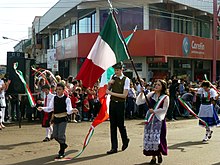
Back أرجنتينيون من أصل إيطالي Arabic آرژانتین ده ایتالیالیلار AZB Inmigración italiana en Argentina Spanish ایتالیایی-آرژانتینی Persian Italo-Argentins French Italia-Argentina ID Italo-argentini Italian イタリア系アルゼンチン人 Japanese 이탈리아계 아르헨티나인 Korean Italo-Argentijnen Dutch
 | |
| Total population | |
| 84,437 (by birth, 2023)[1] + 30,000,000 (by ancestry) 62.5% of Argentina's population[2] | |
| Regions with significant populations | |
| Throughout Argentina (Plurality in the Pampas) | |
| Languages | |
| Argentine Spanish, Rioplatense Spanish, Italian, Piedmontese, Venetian, Neapolitan, Sicilian, Arbërisht and other languages of Italy• Cocoliche pidgin (also Lunfardo slang). | |
| Religion | |
| Catholic Church (Latin Church)[3] (with a small minority of Eastern Catholics of the Byzantine Rite)[4] | |
| Related ethnic groups | |
| Italians, Italian Americans, Italian Bolivians, Italian Brazilians, Italian Canadians, Italian Chileans, Italian Colombians, Italian Costa Ricans, Italian Cubans, Italian Dominicans, Italian Ecuadorians, Italian Guatemalans, Italian Haitians, Italian Hondurans, Italian Mexicans, Italian Panamanians, Italian Paraguayans, Italian Peruvians, Italian Puerto Ricans, Italian Salvadorans, Italian Uruguayans, Italian Venezuelans |
Italian Argentines (Italian: italo-argentini; Spanish: italoargentinos, or tanos in Rioplatense Spanish) are Argentine-born citizens who are fully or partially of Italian descent, whose ancestors were Italians who emigrated to Argentina during the Italian diaspora, or Italian-born people in Argentina.
Between the 1850s and the 1950s, 3.5 million Italians immigrated to Argentina.[5] It was estimated that at least 30 million Argentines (62.5% of the country's population) have some degree of Italian ancestry.[2] Argentina has the second-largest community of Italians outside of Italy, after Brazil. Contingents of Italian immigrants arrived in Argentina from all regions of Italy, mainly from Northern Italy in the 19th century and mostly from Southern Italy in the 20th century.[6]
Italian community in Argentina, along with Spanish immigrants, became a major part of modern Argentine society. Argentine culture has significant connections to Italian culture in terms of language, customs, and traditions. Argentina is also a strongly Italophilic country as cuisine, fashion and lifestyle has been sharply influenced by Italian immigration.[7][8] Italian foods such as panettone (pan dulce), pasta, fainá, olive oil, pizza, vermouth and fernet have become part of the Argentine cuisine, and Italian immigrants were one of the influences in the development of the Argentine wine industry.[9]
- ^ "Datos sociodemográficos por país de nacimiento". RENAPER - Dirección Nacional de Población. Retrieved 15 November 2023.
- ^ a b Departamento de Derecho y Ciencias Políticas de la Universidad Nacional de La Matanza (14 November 2011). "Historias de inmigrantes italianos en Argentina" (in Spanish). infouniversidades.siu.edu.ar. Archived from the original on 15 July 2015.
Se estima que en la actualidad, el 90% de la población argentina tiene alguna ascendencia europea y que al menos 25 millones están relacionados con algún inmigrante de Italia.
- ^ "Argentina – Language and religion | Britannica". Archived from the original on 6 March 2023. Retrieved 17 February 2023.
- ^ Cite error: The named reference
appuntiwas invoked but never defined (see the help page). - ^ "A Brief History of Italian Immigration in Argentina". Archived from the original on 23 February 2024. Retrieved 23 February 2024. Retrieved 23 February 2024
- ^ "Immigrati italiani in Argentina per regione (1880–1929)" (in Italian). 2007. Archived from the original on 30 May 2021. Retrieved 15 February 2022.
- ^ "O.N.I. – Department of Education of Argentina" (in Spanish). Archived from the original on 15 September 2008. Retrieved 16 February 2023.
- ^ Cite error: The named reference
INETwas invoked but never defined (see the help page). - ^ "Immigrant Pantry". Bridge to Argentina. Archived from the original on 24 February 2024. Retrieved 23 February 2024.